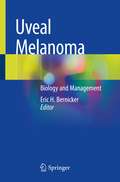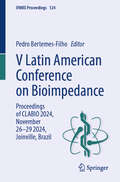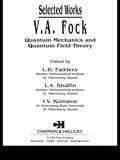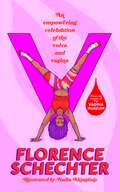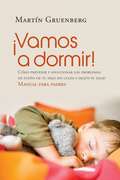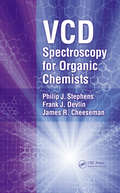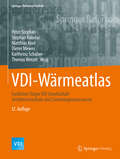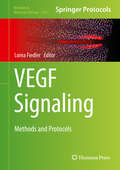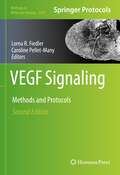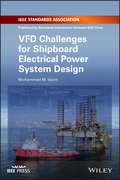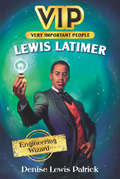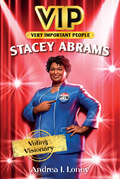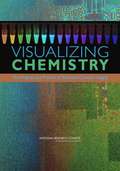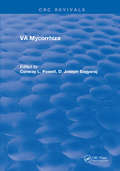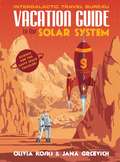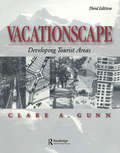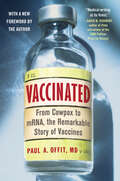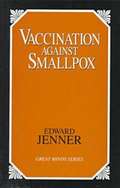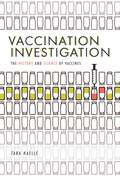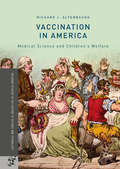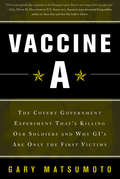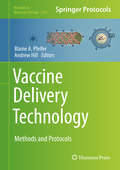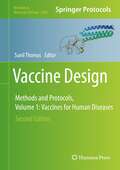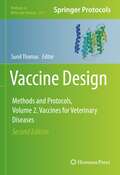- Table View
- List View
Uveal Melanoma: Biology and Management
by Eric H. BernickerThis book provides a comprehensive examination of uveal melanoma, a rare neoplasm that carries a very high mortality and whose natural history makes it fairly unique among adult tumors. Split into three sections, this book explores the basic science behind the disease and inherited genetic syndromes that predispose some patients, as well as the pathology and use of gene expression profiling to determine risk of recurrence. It also focuses on the management of the primary tumor in the eye, including surgical intervention and lesion imaging. Elucidating treatment options for metastatic disease, the book reviews chemotherapy agents and immunotherapy approaches, as well as liver-directed therapies, cellular therapies, and various treatments after primary treatment but before the development of metastases.Uveal Melanoma: Biology and Management is the most up-to-date and comprehensive text devoted solely to this disease and will be useful to medical oncologists, ophthalmologists, radiation therapists, interventional radiologists, pathologists, molecular biologists and immunology researchers, as well as trainees in those fields.
V Latin American Conference on Bioimpedance: Proceedings of CLABIO 2024, November 26-29, 2024, Joinville, Brazil (IFMBE Proceedings #124)
by Pedro Bertemes-FilhoThis book offers a timely snapshot on the developments in the field of bioimpedance, covering diverse applications such as in medicine, food industry and other fields. Gathering the proceedings of the X Latin American Conference on Bioimpedance, CLABIO 2024, held online on November 26-29 2024, from Joinville, Brazil, this book highlights key findings in the field, as well as the results of interdisciplinary discussion between different researchers and stakeholders from the fields of Biomedical Engineering, Medical Physics, Medicine, Environmental Science, Biology, and Chemistry. It offers extensive information on bioimpedance and related technologies, and a lively discussion on future challenges and technologies.
V.A. Fock - Selected Works: Quantum Mechanics and Quantum Field Theory
by L. D. Faddeev L. A. Khalfin I. V. KomarovIn the period between the birth of quantum mechanics and the late 1950s, V.A. Fock wrote papers that are now deemed classics. In his works on theoretical physics, Fock not only skillfully applied advanced analytical and algebraic methods, but also systematically created new mathematical tools when existing approaches proved insufficient. This co
V: An empowering celebration of the vulva and vagina
by Florence SchechterFrom the creator of the world's first Vagina Museum, discover your go-to guide to the vulva.The Vulva. For thousands of years, our vulvas and vaginas have been considered mysterious, taboo and shameful. In fact, 50%* of us, don't even know where the vagina actually is.In this uplifting, informative, witty and empowering guide, we'll explore:- How to label a vulva- The power of periods and the many myths around them- How vulvas have inspired art, folklore and music throughout history and across the world- How to cut through the noise of the feminine hygiene industry- How to feel empowered to call a vulva a vulva!Packed with fascinating contributions from leading activists and experts, V will help every reader discover their own BIG V ENERGY*2021
VAMOS A DORMIR! (EBOOK)
by Martin GruenbergEs necesario dejar llorar a nuestro hijo para que aprenda a dormir? En este libro el doctor Martín Gruenberg, médico pediatra y apasionado investigador de los problemas del sueño infantil, explica que dejar llorar a un niño para enseñarle a dormir es una herramienta que, utilizada de manera inadecuada, puede resultar contraproducente. También nos enseña a reconocer las distintas etapas madurativas por las que puede estar atravesando nuestro hijo y cómo resolver los trastornos de sueño asociados a ellas, respetando sus necesidades afectivas y emocionales. Con ejemplos y sugerencias prácticas ofrece distintas soluciones para otros temas relacionados con el sueño, como el ronquido y la enuresis, y nos sorprende con consejos útiles y aplicables para poner límites claros de acuerdo a la edad de cada niño.
VCD Spectroscopy for Organic Chemists
by Philip J. Stephens Frank J. Devlin James R. CheesemanStimulated by the increasing importance of chiral molecules as pharmaceuticals and the need for enantiomerically pure drugs, techniques in chiral chemistry have been expanded and refined, especially in the areas of chromatography, asymmetric synthesis, and spectroscopic methods for chiral molecule structural characterization. In addition to synthet
VDI-Wärmeatlas: Fachlicher Träger VDI-Gesellschaft Verfahrenstechnik und Chemieingenieurwesen (Springer Reference Technik)
by Thomas Wetzel Karlheinz Schaber Peter Stephan Matthias Kind Stephan Kabelac Dieter MewesGeschrieben von Spezialisten aus Industrie und Wissenschaft, ermöglicht das Standardwerk die Auslegung technischer Apparate und Anlagen, z. B. in der Verfahrens- und der Energietechnik. Dafür werden Daten bereitgestellt, Berechnungsmethoden eingehend erläutert und Konstruktionen vorgestellt. Die 11. deutsche Auflage enthält zahlreiche neue Beiträge, die Kapitel wurden komplett überarbeitet und dem Stand der Technik angepasst. Seit über 50 Jahren ein unentbehrliches Arbeitsmittel für Ingenieure, die sich mit Fragen der Wärmeübertragung beschäftigen.
VEGF Signaling
by Lorna FiedlerThis volume provides a collection of protocols for studying and manipulating VEGF signaling pathways in vitro and in vivo, and in particular, aims to present a range of both firmly established and newly emerging technologies, including those that are amenable to aiding in drug discovery or pre-clinical investigations. Each of the three sections begins with an introductory overview followed by supporting relevant methods. A major advantage of this book is that each chapter not only contains methodological detail rarely seen in other literature, but also contains a section on key notes and troubleshooting advice. Part I focuses on quantification of specific VEGF and VEGF receptor isoforms, beginning with a summary on VEGF splice variants, their function and their regulation. Part II relates to the study of VEGF dependent signaling in vitro, starting with a comprehensive overview of VEGF-mediated signal transduction in the cardiovascular system that highlights recent discoveries in the field. Part III first details genetic mouse models, then discusses techniques for studying physiological angiogenesis in the developing mouse embryo. Written in the highly successful Methods in Molecular Biology series format, chapters include introductions to their respective topics, lists of the necessary materials and reagents, step-by-step, readily reproducible laboratory protocols and tips on troubleshooting and avoiding known pitfalls. Cutting-edge and thorough, VEFG Signaling: Methods and Protocols is a useful tool for researching and understanding the basic biology of VEGF signaling and translating it into the clinic.
VEGF Signaling: Methods and Protocols (Methods in Molecular Biology #2475)
by Lorna R. Fiedler Caroline Pellet-ManyThis volume provides an updated collection of protocols for manipulating and studying VEGF signaling pathways in vitro and in vivo and aims to present a range of both firmly established and newly emerging technologies. Covering multiple model species, from mouse to zebrafish to human, the book explores the role of VEGF and VEGFR isoforms in exosomes, cultured cells, or in tissues, as well as robust cell assays for the investigation of basic angiogenic mechanisms and VEGF signaling in more complex cellular systems, amongst other subjects. Written for the highly successful Methods in Molecular Biology series, chapters include introductions to their respective topics, lists of the necessary materials and reagents, step-by-step, readily reproducible laboratory protocols, and tips on troubleshooting and avoiding known pitfalls. Authoritative and up-to-date, VEGF Signaling: Methods and Protocols, Second Edition provides a useful tool for researchers in the vascular biology community and beyond in understanding the basic biology of VEGF signaling and in translating this research into the clinic.
VFD Challenges for Shipboard Electrical Power System Design
by Mohammed IslamAn in-depth exploration of shipboard power generation and distribution system design that utilizes variable frequency drives The variable frequency drive (VFD) application is a proven technology for shore-based applications. However, shore-based VFDs often are unsuitable for shipboard applications because the power generation and distribution fundamentals are completely different. VFD Challenges for Shipboard Electrical Power System Design explores the problems presented by variable frequency drives as they are applied in shipboard power generation and distribution system design and offers solutions for meeting these challenges. VFDs with configurations such as six pulse drive, 12 pulse drive, 18 pulse drive, active front end, pulse width modulation and many others generate many different levels of harmonics. These harmonics are often much higher than the regulations allow. This book covers a range of techniques used to provide ships with efficient energy that minimizes mechanical and electrical stress. This important book: Offers a comparison of shipboard grounding and VFD grounding Contains an analysis of the VFD effect in terms of shipboard power quality Includes specific examples of Department of Transportation standards regarding VFDs Written for commercial and naval engineers designing ships and/or shipboard power systems, VFD Challenges for Shipboard Electrical Power System Design is a comprehensive resource that addresses the problems and solutions associated with shipboard applications of VFD.
VIP: Engineering Wizard (VIP #1)
by Denise Lewis PatrickGet ready to light up the world with Lewis Latimer in this exciting middle grade nonfiction biography. Perfect for fans of the Who Was and Little Leaders series, the books in the VIP series tell the true—and amazing—stories of some of history's greatest trailblazers. Meet the VERY IMPORTANT PEOPLE who changed the world! Lewis Latimer was one of the greatest inventors of his time. He was also an engineer who transformed the lightbulb at Thomas Edison’s company. And he was a gifted artist, too! Experience all the exciting moments in Lewis Latimer’s thrilling life in this exciting biography, packed with two-color illustrations and fun facts, like who invented the Super Soaker!Short and engaging chapters are interspersed with special lists and other information made to order to engage kids, whether they're already biography fans or "have to" write a report for school. Extras include a timeline, a bibliography, and a hall of fame of other successful African American inventors.The VIP series features inspiring adventures and fun facts about some of history's greatest trailblazers—smart, tough, persevering innovators who will inspire today's kids. Featuring underappreciated historical figures and groups, with a focus on leaders in science and technology, the nonfiction biographies in the VIP series are fun and engaging. Just looking at the cover will make kids want to learn more about these VIPs, and once they dive in they will zoom through stories that read like adventures.Each book in the VIP series allows your middle grader to experience all the exciting moments in some very important but lesser known lives. These biographies for kids age 9-12 include: VIP: Dr. Mae Jemison: Brave Rocketeer: Engineering Wizard; VIP: Mahalia Jackson: Freedom's Voice; and VIP: Lydia Darragh: Unexpected Spy.
VIP: Voting Visionary (VIP)
by Andrea J. LoneyGet ready to fight for what’s right with Stacey Abrams in this exciting middle grade nonfiction biography. Perfect for fans of the Who Was and Little Leaders series, the books in the VIP series tell the true—and amazing—stories of some of history's greatest trailblazers. Meet the VERY IMPORTANT PEOPLE who changed the world!Stacey Abrams is an activist who works for fair voting rights. She’s a lawyer, an author, and a Nobel Peace Prize nominee, too! Experience all the exciting moments in Stacey’s thrilling life in this exciting biography, packed with two-color illustrations and fun facts, like how the census helps everyone!Short and engaging chapters are interspersed with special lists and other information made to order to engage kids, whether they're already biography fans or "have to" write a report for school. Extras include a timeline, a bibliography, and a hall of fame of other successful African American organizers and leaders.The VIP series features inspiring adventures and fun facts about some of history's greatest trailblazers—smart, tough, persevering innovators who will inspire today's kids. Featuring underappreciated historical figures and groups, with a focus on leaders in science and technology, the nonfiction biographies in the VIP series are fun and engaging. Just looking at the cover will make kids want to learn more about these VIPs, and once they dive in they will zoom through stories that read like adventures.Each book in the VIP series allows your middle grader to experience all the exciting moments in some very important but lesser known lives. These biographies for kids age 9-12 include: VIP: Dr. Mae Jemison: Brave Rocketeer: Engineering Wizard; VIP: Mahalia Jackson: Freedom's Voice; and VIP: Lewis Latimer.
VISUALIZING CHEMISTRY: The Progress and Promise of Advanced Chemical Imaging
by National Research Council of the National AcademiesScientists and engineers have long relied on the power of imaging techniques to help see objects invisible to the naked eye, and thus, to advance scientific knowledge. These experts are constantly pushing the limits of technology in pursuit of chemical imaging&#8212the ability to visualize molecular structures and chemical composition in time and space as actual events unfold&#8212from the smallest dimension of a biological system to the widest expanse of a distant galaxy. Chemical imaging has a variety of applications for almost every facet of our daily lives, ranging from medical diagnosis and treatment to the study and design of material properties in new products. In addition to highlighting advances in chemical imaging that could have the greatest impact on critical problems in science and technology, Visualizing Chemistry reviews the current state of chemical imaging technology, identifies promising future developments and their applications, and suggests a research and educational agenda to enable breakthrough improvements.
Va Mycorrhiza
by PowelThis book discusses VA Mycorrhizae fungi, its anatomy, morphology, and ecology, as well as its taxonomy. The isolation and culture of VA Mycorrhizal (VAM) fungi is also discussed. Other topics include; Mycorrhizae in plant growth, biological interactions with VA Mycorrhizal, the physiology of VA Mycorrhizal associations, inoculum production and field inoculation with VA Mycorrhizal fungi.
Vacation Guide to the Solar System: Science for the Savvy Space Traveler!
by Jana Grcevich Olivia KoskiPacked with real science and fueled by imagination, a beautifully illustrated guide to traveling in our solar systemImagine taking a hike along the windswept red plains of Mars to dig for signs of life, or touring one of Jupiter's sixty-four moons where you can photograph its swirling storms. For a shorter trip on a tight budget, the Moon is quite majestic and very quiet if you can make it during the off-season. Packed with full color illustrations and real-world science, Vacation Guide to the Solar System is the must-have planning guide for the curious space adventurer, covering all of the essentials for your next voyage, how to get there, and what to do when you arrive. Perfect for fans of Neil deGrasse Tyson's Astrophysics for People in a Hurry, this tongue-in-cheek reference guide is an imaginative exploration into the “What if” of space travel, sharing fascinating facts about space, the planets in our solar system, and even some moons!
Vacationscape: Developing Tourist Areas
by Clare A. GunnThe third edition of this classic volume integrates the idea of balancing tourism with protection of the resources upon which it depends. The text stresses the role of the community, identifies potential pitfalls, and raises issues of developmental ethics. It includes topics such as environmental impact, sustainability, and ecotourism. Special emphasis is given to the growing need for business to implement environmental protection and ecological integrity as an essential part of economic development. The book is filled with many sketches, functional diagrams, and photographs.
Vaccinated: From Cowpox to mRNA, the Remarkable Story of Vaccines
by Paul A. Offit M.D.Vaccines save millions of lives every year, and one man, Maurice Hilleman, was responsible for nine of the big fourteen. Paul Offit recounts his story and the story of vaccines Maurice Hilleman discovered nine vaccines that practically every child gets, rendering formerly dread diseases—including often devastating ones such as mumps and rubella—practically forgotten. Paul A. Offit, a vaccine researcher himself, befriended Hilleman and, during the great man’s last months, interviewed him extensively about his life and career. Offit makes an eloquent and compelling case for Hilleman’s importance, arguing that, like Jonas Salk, his name should be known to everyone. But Vaccinated is also enriched and enlivened by a look at vaccines in the context of modern medical science and history, ranging across the globe and throughout time to take in a fascinating cast of hundreds, providing a vital contribution to the continuing debate over the value of vaccines.
Vaccinated: The history and science of immunisation
by Sarah RidleyIn the wake of Covid-19, this book is a great first introduction as to what vaccines are, how scientists first developed them, information about the Covid-19 vaccination race, and other serious illnesses including malaria. The book includes the science behind germs and the immune system, the first inoculations performed in China using smallpox scabs, details of the early adopters of inoculation such as Lady Montagu in Europe and Cotton Mather in the USA, leading to Edward Jenner and the creation of the first vaccine.As well as the history of vaccines, the book looks at the modern science and issues around vaccines, covering topics, such as how you vaccinate the world, herd immunity, vaccine hesitancy and anti-vaxxers. The text is illustrated with archive and modern photography.
Vaccination Against Smallpox
by Edward JennerIn the three treatises contained in this volume, originally published between 1798 and 1800, Jenner, who was a pioneer in demonstrating that vaccination was an effective means of preventing smallpox, summarizes his evidence in favor of vaccination and describes individual cases.
Vaccination Investigation: The History and Science of Vaccines
by Tara HaelleVaccines are biological substances that cause the human immune system to build up its defenses against specific diseases. Public health officials recommend a series of vaccines for all children, as well as some vaccines for teenagers and adults. But not everyone gets the vaccines they need. Many poor nations don't have the resources to deliver vaccines to every community. Some parents refuse to have their children vaccinated because they don't believe the evidence proving that vaccines are safe. The effort to wipe out diseases using vaccines continues. Vaccine Investigation recounts the fascinating history of vaccines, their important role in protecting community health, and the excitement of cutting-edge research.
Vaccination in America: Medical Science and Children’s Welfare (Palgrave Studies in the History of Science and Technology)
by Richard J. AltenbaughThe success of the polio vaccine was a remarkable breakthrough for medical science, effectively eradicating a dreaded childhood disease. It was also the largest medical experiment to use American schoolchildren. Richard J. Altenbaugh examines an uneasy conundrum in the history of vaccination: even as vaccines greatly mitigate the harm that infectious disease causes children, the process of developing these vaccines put children at great risk as research subjects. In the first half of the twentieth century, in the face of widespread resistance to vaccines, public health officials gradually medicalized American culture through mass media, public health campaigns, and the public education system. Schools supplied tens of thousands of young human subjects to researchers, school buildings became the main dispensaries of the polio antigen, and the mass immunization campaign that followed changed American public health policy in profound ways. Tapping links between bioethics, education, public health, and medical research, this book raises fundamental questions about child welfare and the tension between private and public responsibility that still fuel anxieties around vaccination today.
Vaccine A: The Covert Government Experiment That's Killing Our Soldiers -- and Why GI's Are Only the First Victims
by Gary MatsumotoIn this provocative look at the US military from the Persian Gulf War through the 2003 invasion of Iraq, investigative journalist Gary Matsumoto contends that an anthrax vaccine dispensed by the Department of Defense was the cause of Gulf War Syndrome and the origins of a massive cover-up. Matsumoto calls it the worst friendly-fire incident in military history. A skillfully-woven narrative that serves as a warning about this man-made epidemic, Vaccine A is a much needed account of just what went wrong, and why.
Vaccine Delivery Technology: Methods and Protocols (Methods in Molecular Biology #2183)
by Andrew Hill Blaine A. PfeiferThis volume discusses the vaccine development process and the role delivery concepts contribute to a global goal of effective health outcomes. The chapters in this book cover a wide range of topics such as antigen discovery methods; genetic and protein antigen preparation; preparation of viral vaccines as VLPs; viral and non-viral gene delivery; needle-less or non-invasive delivery technology; vaccine storage; and vaccine administration and assessment. Written in the highly successful Methods in Molecular Biology series format, chapters include introductions to their respective topics; lists of the necessary materials and reagents; step-by-step, readily reproducible laboratory protocols; and tips on troubleshooting and avoiding known pitfalls.Cutting-edge and practical, Vaccine Delivery Technology: Methods and Protocols is a valuable resource for both novice and expert researchers, in and outside the field, who would like to gain insight into the impactful field of vaccines. Chapter 7 is available open access under a Creative Commons Attribution 4.0 International License via link.springer.com.
Vaccine Design: Methods and Protocols, Volume 1. Vaccines for Human Diseases (Methods in Molecular Biology #2410)
by Sunil ThomasThis volume provides a practical guide providing step-by-step protocol to design and develop vaccines for human diseases. Divided into three volumes, Volume 1: Vaccines for Human Diseases guides readers through an introductory section on future challenges for vaccinologists and the immunological mechanism of vaccines. Chapters focus on design of human vaccines for viral, bacterial, fungal, and parasitic diseases as well as tumor vaccines. Written in the format of the highly successful Methods in Molecular Biology series, each chapter includes an introduction to the topic, lists necessary materials and reagents, includes tips on troubleshooting and known pitfalls, and step-by-step, readily reproducible protocols. Authoritative and practical, Vaccine Design: Methods and Protocols, Second Edition, Volume 1: Vaccines for Human Diseases aims to be a useful practical guide to researchers to help further their study in this field.
Vaccine Design: Methods and Protocols, Volume 2. Vaccines for Veterinary Diseases (Methods in Molecular Biology #2411)
by Sunil ThomasThis volume provides a practical guide providing step-by-step protocol to explore vaccines for farm and companion animals, as well as for fish and insects. Divided into three volumes, Volume 2: Vaccines for Veterinary Diseases guides readers through veterinary vaccines, vaccines for poultry, vaccines for farm animals, and vaccines for veterinary parasites. Written in the format of the highly successful Methods in Molecular Biology series, each chapter includes an introduction to the topic, lists necessary materials and reagents, includes tips on troubleshooting and known pitfalls, and step-by-step, readily reproducible protocols. Authoritative and practical, Vaccine Design: Methods and Protocols, Second Edition, Volume 2: Vaccines for Veterinary Diseases aims to be a useful practical guide to researchers to help further their study in this field.
